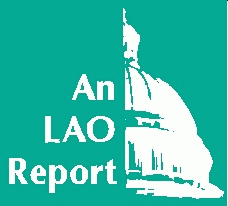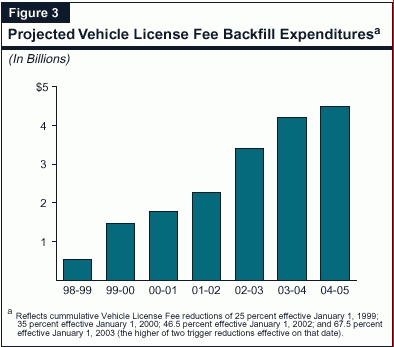
 |
California's Fiscal OutlookLAO Projections 1999-00 to 2001-02Part I |
This report provides our projections of General Fund revenues and expenditures for 1999-00 through 2004-05. It includes our independent assessment of the outlook for the economy, demographics, revenues, and expenditures. It is designed to assist the Legislature with its fiscal planning.
Chapter 1 contains our principal findings and conclusions. Chapter 2 presents our economic and demographic projections, Chapter 3 our revenue forecasts, and Chapter 4 our expenditure projections.
Our fiscal projections reflect current-law spending requirements and tax provisions. They are not predictions of future policy decisions by the Legislature, nor are they our recommendations as to what spending and revenue levels should be. The report is part of an ongoing series and is updated periodically.
California's fiscal fortunes have again significantly exceeded expectations, due largely to its robust economic performance and the accompanying increases in General Fund revenues. We project that continued revenue growth will trigger all of the vehicle license fee (VLF) reductions previously agreed to, enable full funding of all current-law programs, and produce significant budgetary reserves in the next several years.
As indicated in Figures 1 and 2, we now project that 1999-00 will end with a reserve of nearly $2.6�billion, up substantially from the $881�million forecast just five months ago when the budget was adopted. In 2000-01, the reserve would grow further to slightly over $3�billion. In the subsequent four years, revenues and expenditures would increase at about the same average rate, and a good-sized reserve would be maintained throughout the forecast period, assuming current policies.
| Figure 1 |
| Key Findings of the LAO Outlook |
| Economy and Revenues Again Exceed Expectations |
|
|
|
| Balanced Budgets With Significant Reserves Projected Over Long Term |
|
|
|
|
| Implications |
|
|
|
| Figure 2 | |||
| LAO Projections of General Fund Condition | |||
| 1998-99 Through 2000-01
(In Millions) | |||
| 1998-99 | Forecast | ||
| 1999-00 | 2000-01 | ||
| Prior-year fund balance | $3,064 | $3,099 | $3,071 |
| Revenues and transfers | 58,614 | 64,849 | 67,906 |
| Total resources available | $61,678 | $67,948 | $70,977 |
| Expenditures | $58,579 | $64,877 | $67,479 |
| Ending fund balance | $3,099 | $3,071 | $3,498 |
| Other obligations | $480 | $480 | $480 |
| Reserve | $2,619 | $2,591 | $3,018 |
The single largest factor behind the improved budgetary outlook is the strong performance of the U.S. and California economies, which have continued to outperform expectations by a significant margin. Based on our current estimates, U.S. real gross domestic product will expand by just under 4�percent for the third year in a row in 1999, due to particularly strong increases in consumer spending and business investment. These national trends are clearly evident in California, where such measures as personal income, employment, and retail sales are up sharply this year.
Our forecast assumes that economic growth will slow some over the next two years, but still continue at a solid pace. For example, we project that California personal income growth will slow from 6.7�percent in 1999, to 6.1�percent in 2000. In subsequent years we project that personal income will continue to expand at annual rates of between 5�percent and 6�percent. Our economic forecast for the full projection period is somewhat stronger than our previous long-term projections, reflecting an upward assessment regarding the rate at which the economy is able to grow over the long term.
We forecast that General Fund revenues will increase from $58.6�billion in 1998-99 to $64.8�billion in 1999-00, and further to $67.9�billion in 2000-01. Relative to the 1999-00 Budget Act forecast, our estimate for 1998-99 is up $684�million, reflecting strong receipts during the early months of this fiscal year which will be accrued back to the prior year. Our forecast for 1999-00 is up by nearly $1.9�billion, due to both the improved economic outlook, and stronger-than-expected monthly receipts from key sources such as personal income tax withholding and sales tax payments.
Over the longer term, revenues are forecast to expand roughly in line with statewide personal income, increasing at an annual rate of about 5.6�percent, and reaching $84.4�billion by 2004-05.
The 1999-00 budget assumed that the fiscal year would end with a reserve of $881�million. In contrast, our updated estimates result in a 1999-00 year-end reserve of over $2.6�billion. The $1.7�billion improvement is the net result of a $2.6�billion increase in revenues ($687�million in 1998-99 and $1.9�billion in 1999-00, as discussed above), partly offset by $0.8�billion in higher costs. The added costs are primarily related to higher-than-expected Medi-Cal expenditures, due primarily to lower-than-anticipated receipt of new federal reimbursements.
Basis for Our Estimates. Our revenue and expenditure forecasts for 2000-01 and beyond are based primarily on the requirements of current law. Specifically, we have adjusted the 1999-00 spending plan for constitutional and statutory funding requirements, as well as for projected changes in caseloads, federal reimbursement rates, and other factors affecting program costs. For example:
Finally, our estimates include the impact of future VLF reductions that would be "triggered" under our revenue projections. However, they do not include the impact of court cases pending against the state.
Our fiscal estimates are not predictions of what the Legislature and Governor will adopt as policies and funding levels in future budgets. Nor are they our recommendations of what tax and spending policies ought to be. Rather, our estimates are a baseline projection of what would happen if current-law policies were allowed to run their course. We recognize that the Legislature may choose to make other policy choices as it has in recent years. For example, it may choose to over-appropriate the Proposition�98 minimum funding guarantee. We believe that by using this approach, however, our forecasts provide a meaningful starting point for the Legislatures's evaluation of the state's fiscal condition.
As indicated in Figure�2, we estimate that revenues will rise 4.7�percent to $67.9�billion, and expenditures will increase 4�percent to $67.5�billion during the year. The $427�million operating surplus during the year will raise the 2000-01 year-end reserve to just over $3�billion.
As with revenues (discussed above), the modest growth rate projected for expenditures partly reflects the existence of large one-time outlays in the current year. In terms of major ongoing programs, we project that education spending will increase by about 5�percent next year, that Medi-Cal and Supplemental Security Income/State Supplementary Programs (SSI/SSP) will increase by about 7�percent, and that California Work Opportunity and Responsibility to Kids (CalWORKs) spending will decline by nearly 10�percent.
Over the long term, our projections indicate that revenues and expenditures will roughly balance for the 2001-02 through 2004-05 period as a whole. As a result, the $3�billion reserve we project for 2000-01 would remain largely intact at the end of the five-year forecast horizon.
During this period, the year-to-year surplus would fluctuate somewhat due to such factors as the phasing-in of the VLF tax cuts. Revenue growth would be somewhat greater than spending growth related to existing state programs. One reason for this is that General Fund Proposition�98 spending is forecast to grow by about 4.5�percent per year, due largely to slow growth in school enrollments.
However, as noted above, the state will also be facing new obligations which are related to VLF rate reductions (that would be automatically triggered if revenues meet our projections). As indicated in Figure�3, we estimate that state subventions to backfill local revenue losses resulting from the VLF rate reductions will climb from $1.5�billion in the current year, up to $4.5�billion by 2004-05.

Recent economic and revenue developments have helped create an extremely positive budgetary environment for California. Based on our current projections, the state will be able to provide nearly $3�billion in additional VLF tax relief over the next five years, maintain all existing budget commitments, and still have enough resources to finance some new obligations and maintain a reserve.
As the Legislature approaches its 2000-01 budget deliberations in this favorable fiscal climate, it will have the opportunity to both review its existing spending and tax policies to ensure that they reflect current priorities, and decide whether to take on new commitments (either spending or tax relief) in light of the large projected 2000-01 surplus.
If new commitments are desired, however, it will be very important to take into account their long-term fiscal consequences. Given that revenues and expenditures are projected to be about equal to one another during the 2001-02 through 2004-05 period, significant new ongoing budgetary commitments, if not offset by savings elsewhere, would result in reductions in the reserve during this period. As one example, new ongoing budgetary commitments of just $300�million annually beginning in 2000-01 would reduce the $3�billion reserve we project for 2000-01 down to $1.3�billion by the end of 2004-05.
Although the size of reserve is ultimately a legislative policy decision, we believe that, at a minimum, $1.5�billion (or roughly 2�percent of the budget) should be targeted for this purpose. Preferably, the amount would be even higher. The maintenance of a healthy reserve through the next several years is important for at least two reasons: (1) the future performance of the economy is uncertain and (2) the existence of lawsuits and claims that could potentially have significant negative fiscal impacts on the state.
With regard to the economy, a significant economic downturn sometime during the next five years would result in revenues falling well below our projections. We note that the effects of a significant revenue drop-off would be partly mitigated by the fact that some or all the VLF trigger reductions we are projecting might not take place, depending on the circumstances. For example, if revenues were to grow at the subdued pace of 2�percent annually for several years, as much as one-third of the resulting $20-plus billion revenue loss over the period would be offset by reduced expenditures to backfill VLF reductions. In addition, the Proposition�98 minimum funding guarantee and expenditures for certain other state programs would also fall. Even allowing for these adjustments, however, a significant economic slowdown would put immediate pressure on the budget.
With regard to legal challenges, the most immediate potential liability involves an appellate ruling that the state illegally collected smog impact fees from motorists that registered out-of-state cars in California. The Governor has recently declared his intent to make reimbursements of these fees with interest, although the timing and ultimate size of any such reimbursements will depend on legislative action. Other legal issues include (1) pending school district claims before the Commission on State Mandates regarding special education programs, and (2) a recent superior court ruling that the state's previous shift of property taxes from local governments to schools was illegal.
Thus, while the current fiscal climate is very positive, it will be important for the Legislature to be cognizant of the out-year implications of potential fiscal threats and new commitments on either the revenue or expenditure side of the budget to ensure that a balanced budget will be maintained in the future.